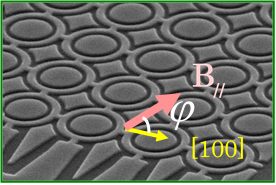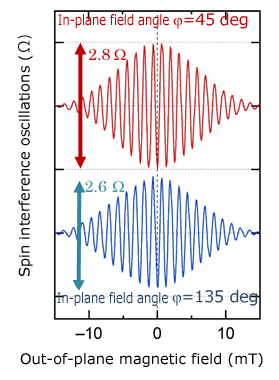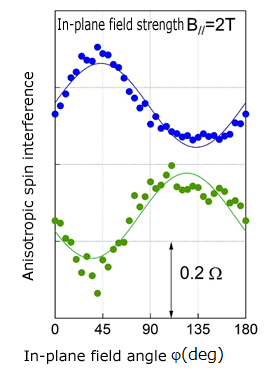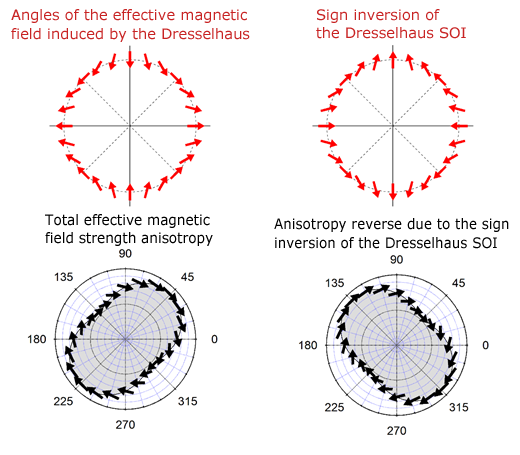News
Research Results
Controlled sign change in the spin-orbit interaction: Quest for extra degrees of freedom in the electric-field control of spins
[Highlights]
- Researchers have observed a sign change in the Dresselhaus spin-orbit interaction caused by the inversion asymmetry of the semiconductor crystal structure.
- Spin interferometry experiments have detected anisotropy in an effective magnetic field induced by the spin-orbit interaction.
- This study contributes significantly to increasing the degrees of freedom and flexibility of electric-field controlled spintronic devices.
[Overview]
A research group consisting of Fumiya Nagasawa (PhD Graduate, Graduate School of Engineering, Tohoku University) and Junsaku Nitta (Professor at the same institution) has conducted collaborative research with a research group led by Diego Frustaglia (Professor, University of Seville, Spain). As a result of detailed theoretical analyses and laboratory experiments on anisotropic spin interference, they demonstrated that the sign of the Dresselhaus spin-orbit interaction (Note 1) in a semiconductor InGaAs two-dimensional electron gas can change depending on the gate voltage.
Spin-orbit coupling, which acts as an effective magnetic field on electron spins, can be controlled by an electric field. This means that the strength and direction of the magnetic field acting on electron spins can be controlled electrically. This study has demonstrated that the combination of a Dresselhaus spin-orbit interaction and a Rashba spin-orbit interaction (Note 2) induced by an electric field in heterostructures can provide extra degrees of freedom to electric-field control of spins, such as electrical control of spin relaxation. The results of this study are expected to contribute significantly to the development of spintronics.
This study was published online in the American journal "Physical Review B" on December 4, 2018. This study was supported by the Japan Society for the Promotion of Science through Grants-in-Aid for Scientific Research.
[Research Background]
Since electron spins have little magnetic properties, conventional studies used a magnetic field to generate, manipulate, and detect spins. In recent years, however, vigorous efforts have been made to develop spintronics devices with new functions by electrically controlling the electron spin degrees of freedom. The spin-orbit interaction obtained as a relativistic correction that produces a magnetic field for electron spins moving in an electric field allows the electric-field control of spins. Recent studies have succeeded in electrical generation, manipulation, and detection of electron spins by using the Rashba spin-orbit interaction induced by the internal electric field in semiconductor quantum wells. Meanwhile, the spin-orbit interaction arising from the inversion asymmetry of the semiconductor crystal structure, as proposed by Gene Dresselhaus in the 1950s, has so far been considered as a material-specific parameter.
[Achievements]
Figure 1 shows the spin interference device prepared in an InGaAs semiconductor quantum well. Experiments using the Rashba spin-orbit interaction to control the phases of electron spins transported through arrays of quantum rings and measuring their electrical conduction have demonstrated that spin interference can be controlled by an electric field. When the Rashba and Dresselhaus spin-orbit interactions coexist, the strength of the total effective magnetic field induced by the combination of these two spin-orbit interactions shows anisotropy. As shown in Figure 2, this anisotropic effective magnetic field can be observed as the amplitude of the spin interference oscillations, which varies depending on the in-plane magnetic field angle. Moreover, as shown in Figure 3, the anisotropy of spin interference oscillations is reversed when changing the Rashba spin-orbit interaction by applying different gate voltages to the rings. It has also been confirmed that the sign of the Rashba spin-orbit interference remains unchanged at these gate voltages. As a result of theoretical comparison (Figure 4), we have concluded that the spin interference anisotropy reversal shown in Figure 3 is caused by the sign inversion of the Dresselhaus spin-orbit interaction.

Figure 1: Spin interference device

Figure 2: In-plane field angle dependence of spin interference oscillations

Figure 3: Spin interference anisotropy reverse

Figure 4: Angles of the effective magnetic field induced by the Dresselhaus SOI and total effective magnetic field strength anisotropy observed in combination of Dresselhaus and Rashba SOIs
This is the first study that demonstrated that the sign of the Dresselhaus spin-orbit interaction can be reversed by an electric field. Although the Dresselhaus spin-orbit interaction has so far been considered as a material-specific parameter, a theoretical analysis taking the high-order effects of momentum into account suggests that it may vary depending on the carrier density. Since the angles of the effective magnetic fields induced by the Dresselhaus and Rashba spin-orbit interactions are different in symmetry, the combination of these two spin-orbit interactions can provide extra degrees of freedom to the electric-field control of spins.
The gate-controlled sign change of the Dresselhaus spin-orbit interaction demonstrated in this study can be applied not only to semiconductors but also to other compounds. Therefore, the results of this study are expected to contribute to further development of spintronics.
[Publication Information]
Journal: Physical Review
Title: Gate-controlled anisotropy in Aharonov-Casher spin interference: Signatures of Dresselhaus spin-orbit inversion and spin phases
Authors: F. Nagasawa, A. A. Reynoso, J. P. Baltanás, D. Frustaglia, H. Saarikoski, and J. Nitta
URL: https://link.aps.org/doi/10.1103/PhysRevB.98.245301
DOI: 10.1103/PhysRevB.98.245301
[Glossary]
Note 1. Dresselhaus spin-orbit interaction (SOI)
The spin-orbit interaction is a relativistic effect that produces a magnetic field for electron spins moving in an electric field. InGaAs and other compound semiconductors, consisting of Group III and V elements, lack crystal inversion symmetry and induce a micro-electric field. The spin-orbit interaction of electron spins moving in this electric field is called the Dresselhaus spin-orbit interaction. This is why it has so far been considered as a material-specific parameter.
Note 2. Rashba spin-orbit interaction (SOI)
This is the spin-orbit interaction originating from the electric field created by the potential gradient in a quantum well of different semiconductor heterostructures. As reported in previous studies, the Rashba spin-orbit interaction can be controlled by electrical means because the electric field acting on electron spins can vary depending on the gate voltage applied to the quantum well.
Links:
Tohoku University (Japanese)
Graduate School of Engineering, Tohoku University (Japanese)



